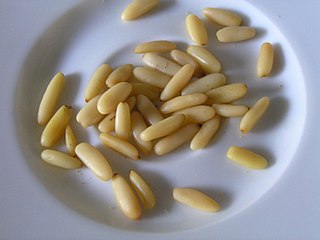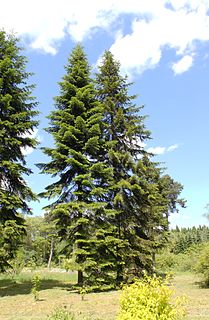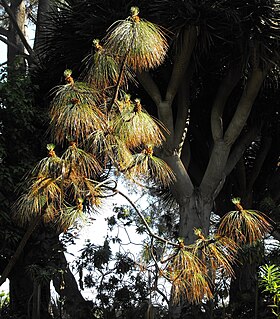
Tannins are a class of astringent, polyphenolic biomolecules that bind to and precipitate proteins and various other organic compounds including amino acids and alkaloids.

Pine nuts, also called piñón, pinoli, pignoli or chilgoza, are the edible seeds of pines. According to the Food and Agriculture Organization, only 29 species provide edible nuts, while 20 are traded locally or internationally owing to their seed size being large enough to be worth harvesting; in other pines, the seeds are also edible, but are too small to be of notable value as a human food.

Pinus nigra, the Austrian pine or black pine, is a moderately variable species of pine, occurring across Southern Europe from the Iberian Peninsula to the eastern Mediterranean, on the Anatolian peninsula of Turkey, Corsica and Cyprus, as well as Crimea and in the high mountains of Northwest Africa.

Pinus jeffreyi, also known as Jeffrey pine, Jeffrey's pine, yellow pine and black pine, is a North American pine tree. It is mainly found in California, but also in the westernmost part of Nevada, southwestern Oregon, and northern Baja California. It is named in honor of its botanist documenter John Jeffrey.

Pinus contorta, with the common names lodgepole pine and shore pine, and also known as twisted pine, and contorta pine, is a common tree in western North America. It is common near the ocean shore and in dry montane forests to the subalpine, but is rare in lowland rain forests. Like all pines, it is an evergreen conifer.

Pinus pumila, commonly known as the Siberian dwarf pine, dwarf Siberian pine, dwarf stone pine, Japanese stone pine, or creeping pine, is a tree in the family Pinaceae native to northeastern Asia and the Japanese isles. It shares the common name creeping pine with several other plants.

The Coulter pine or big-cone pine, Pinus coulteri, is a native of the coastal mountains of Southern California in the United States and northern Baja California in Mexico. Isolated groves are found as far north as Clearlake, California on the flanks of Mt. Konocti and Black Diamond Mines Regional Preserve. It is named after Thomas Coulter, an Irish botanist and physician. The Coulter pine produces the heaviest cone of any pine tree, up to 5 kg (11 lb).

Pinus ponderosa, commonly known as the ponderosa pine, bull pine, blackjack pine, western yellow-pine, or filipinus pine is a very large pine tree species of variable habitat native to mountainous regions of western North America. It is the most widely distributed pine species in North America.

Pinus cembra, also known as Swiss pine, Swiss stone pine or Arolla pine or Austrian stone pine or just stone pine, is a species of a pine tree in the subgenus Strobus.

Pinus sibirica, or Siberian pine, in the family Pinaceae is a species of pine tree that occurs in Siberia from 58°E in the Ural Mountains east to 126°E in the Stanovoy Range in southern Sakha Republic, and from Igarka at 68°N in the lower Yenisei valley, south to 45°N in central Mongolia.

Gnetum is a genus of gymnosperms, the sole genus in the family Gnetaceae within the Gnetophyta. They are tropical evergreen trees, shrubs and lianas. Unlike other gymnosperms, they possess vessel elements in the xylem. Some species have been proposed to have been the first plants to be insect-pollinated as their fossils occur in association with extinct pollinating scorpionflies. Molecular phylogenies based on nuclear and plastid sequences from most of the species indicate hybridization among some of the Southeast Asian species. Fossil-calibrated molecular-clocks suggest that the Gnetum lineages now found in Africa, South America and Southeast Asia are the result of ancient long-distance dispersal across seawater.

Pinus halepensis, commonly known as the Aleppo pine, also known as the Jerusalem pine, is a pine native to the Mediterranean region.

The University of Illinois Conservatory and Plant Collection is a 2,000-square-foot (190 m2) conservatory and botanical garden located in the Plant Sciences Laboratory Greenhouses, on the University of Illinois at Urbana–Champaign campus, 1201 South Dorner Drive, Urbana, Illinois. The conservatory is generally open to the public daily when the university is in session, though it may be closed for classes, research, or special events.

Abies sibirica, the Siberian fir, is a coniferous evergreen tree native to the taiga east of the Volga River and south of 67°40' North latitude in Siberia through Turkestan, northeast Xinjiang, Mongolia and Heilongjiang.

Pinus massoniana is a species of pine, native to Taiwan, a wide area of central and southern China, and northern Vietnam.

Pinus montezumae, known as the Montezuma pine, is a species of conifer in the family Pinaceae.

Aromadendrin is a flavanonol, a type of flavonoid. It can be found in the wood of Pinus sibirica.

Rhapontigenin is a stilbenoid. It can be isolated from Vitis coignetiae or from Gnetum cleistostachyum.

Oligostilbenoids are oligomeric forms of stilbenoids. Some molecules are large enough to be considered polyphenols and constitute a class of tannins.

Pinus pumila × P. sibirica is a putative hybrid of Japanese stone pine and Siberian pine. It has not yet been officially described.




















